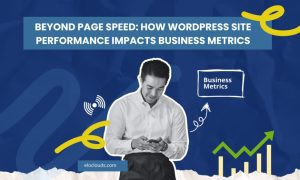Website performance is often discussed purely in technical terms—load times, server response, and optimization techniques. However, for businesses running WordPress sites, performance has profound implications that extend far beyond technical metrics into core business outcomes. Let’s explore how WordPress performance directly impacts your bottom line.
The Real Cost of Slow WordPress Sites
While developers focus on milliseconds and optimization, business leaders should think in terms of:
- Customer acquisition costs
- Conversion rates
- Customer lifetime value
- Brand perception
- Operational efficiency
According to research by Portent, sites that load in 1 second have conversion rates 3x higher than those that load in 5 seconds. This difference translates directly to revenue.
Performance Impact on Customer Journey Metrics
1. Acquisition Costs
Google now includes Core Web Vitals in ranking algorithms, meaning poor site performance reduces organic visibility and increases reliance on paid media.
SEMrush data shows that improving Core Web Vitals can boost organic traffic by up to 30%, effectively reducing acquisition costs.
2. Bounce Rates & Engagement
Performance issues hurt user patience and engagement:
- 53% of mobile users abandon sites that take over 3 seconds to load
- Each second of delay reduces satisfaction by 16%
- 22% drop in session duration with just a 2-second delay
As Google research confirms, poor performance early in the customer journey negatively affects all following metrics.
3. Conversion Performance
Slow WordPress sites lead to measurable drops in engagement:
- Add-to-cart rates drop by 20% per second of delay
- Form completion decreases by 14% per second
- User-generated content submissions fall by 28% on slow-loading sites
Cloudflare reports that improving speed from 8s to 2s increases conversion rates by over 74%.
4. Customer Retention
Speed matters even after the first visit:
- 79% of dissatisfied customers won’t return
- Satisfaction scores drop by 16% per second of delay
- Support ticket volume increases by 12% for every 500ms added
According to Adobe, digital experience quality directly influences repeat purchase behavior.
The Mobile Performance Imperative
With 60–70% of traffic coming from mobile:
- Mobile users are 32% more sensitive to delays
- Poor mobile Core Web Vitals drop conversion rates by 39%
- 50% of mobile users cite loading time as the top reason for cart abandonment
Despite technical challenges, mobile performance expectations are even higher than desktop.
WordPress-Specific Performance Challenges
1. Plugin Proliferation
The average WordPress site uses 22–30 plugins. Each adds weight:
- Each non-essential plugin adds ~35ms to load time
- Annual maintenance costs increase by $150+ due to conflicts and updates
2. Inefficient Database Operations
Over time, WordPress databases fill with unnecessary data:
WP Engine found that cleaning up can improve query performance by 30–60%, accelerating checkouts and admin functions.
3. Image Optimization Failures
Despite tools, 72% of WordPress sites serve unoptimized images, doubling file sizes and slowing sites significantly.
The Business Case for Performance Investment
1. Direct Revenue Impact
For an eCommerce site making $10,000/day:
- A 1-second speed boost = 7% more conversions
- That’s an extra $700/day or $255,500/year
- ROI often exceeds 300% in year one
2. Infrastructure Cost Savings
Optimized WordPress sites require:
- 40–60% less server resources
- Lower bandwidth and CDN expenses
- Reduced database demand
Mid-sized businesses can save $3,000–$7,000/year on hosting.
3. Operational Efficiency
High-performance WordPress sites benefit from:
- 53% fewer troubleshooting hours
- 37% fewer support tickets
- 28% boost in content team productivity
Automattic research shows up to 20 staff hours saved per week.
Beyond Technology: Performance as Business Strategy
1. Marketing KPIs
- Core Web Vitals as performance KPIs
- Performance budgets for features and scripts
- Mobile parity requirements
2. Customer Experience Strategy
- Segment analytics by performance
- Use progressive enhancement for diverse networks
- Design with performance-first principles
3. Competitive Differentiation
Deloitte found brands promoting performance see 18% higher retention in tech-savvy demographics.
Implementation Strategies
1. Incremental Optimization
- Plugin audit and consolidation
- Image optimization
- Hosting upgrades
Yields 30–50% improvement with moderate investment
2. Infrastructure Overhaul
- Container-based architecture
- Global CDN and edge computing
- Server-level caching
Commonly leads to 70–90% improvement
3. Intelligent Hosting Evolution
- AI-optimized WordPress platforms
- Predictive resource allocation
- Auto-healing systems
Delivers 80–95% improvement and slashes maintenance by up to 80%
Conclusion
WordPress performance is not just a technical concern—it’s a business-critical driver. From acquisition to retention, organizations that treat performance as strategy outperform competitors on all major KPIs.
As user expectations rise, the divide between optimized and underperforming sites will grow—making performance a major competitive differentiator.
This article is brought to you by the team at EloClouds, pioneers in intelligent WordPress hosting that delivers exceptional performance—without the maintenance burden.
Learn more about our performance-first platform at eloclouds.com


